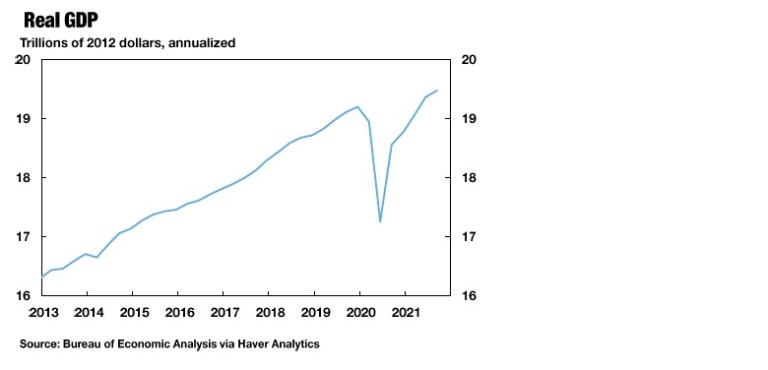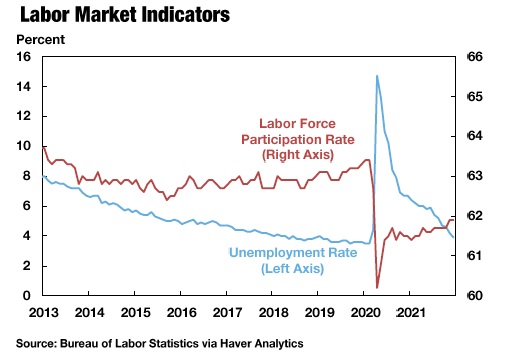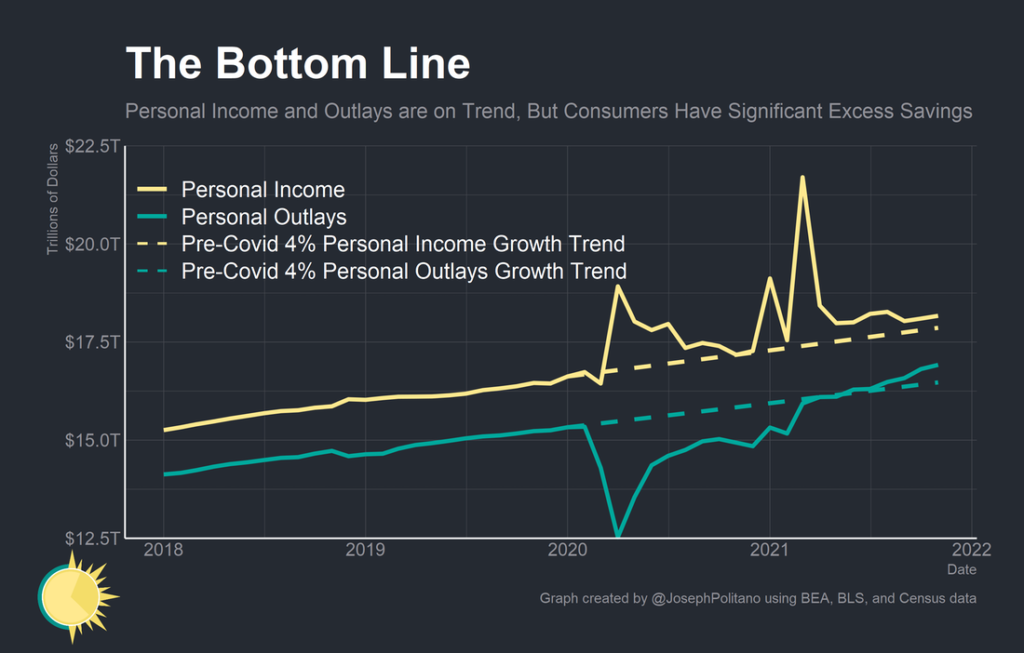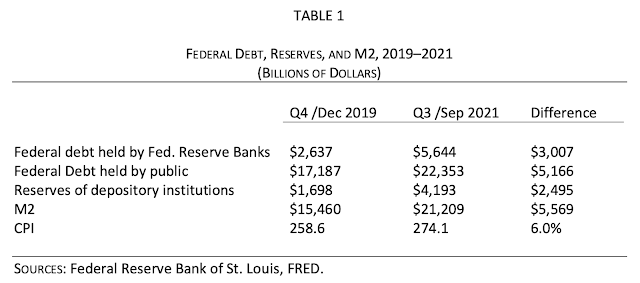Showing posts with label Macro Demystified. Show all posts
Sunday, January 16, 2022
The US Economy as 2022 Begins
From Conversable Economist:
“The Federal Reserve Bank of New York puts out a monthly publication called “U.S. Economy in a Snapshot,” a compilation of figures and short notes about the most recently available major macroeconomic statistics. As we take a deep breath and head into 2022, it seemed a useful time to consult pass along some these figures as as a way of showing the path of the US economy since the two-month pandemic recession of March and April 2020.
Here’s the path of GDP growth. It has clearly bounced back from the worse of the recession, but it still remains about 2% below the trend-line from before the recession occurred.
Part of the reason why GDP has not rebounded more fully lies in what is being called the “Great Resignation”–that is, people who left the workforce during the pandemic and have not returned. Just to be clear, to be counted as officially “unemployed” you need to be both out of a job and actively looking for a job. If you are out of a job but not looking, then you are “out of the labor force.” Thus, you can see that while the unemployment rate based on those out of a job and actively looking for work is back down to pre-pandemic levels, the labor force participation rate–which combines those who have job and the unemployed who are looking–has not fully rebounded. A smaller share of the labor force working will typically translate into a smaller GDP. When or if these potential workers return to the workforce will have a big effect on the future evolution of the economy and public policy.”


From Conversable Economist:
“The Federal Reserve Bank of New York puts out a monthly publication called “U.S. Economy in a Snapshot,” a compilation of figures and short notes about the most recently available major macroeconomic statistics. As we take a deep breath and head into 2022, it seemed a useful time to consult pass along some these figures as as a way of showing the path of the US economy since the two-month pandemic recession of March and April 2020.
Posted by at 8:03 AM
Labels: Macro Demystified
Saturday, January 15, 2022
The Inflation Outlook
As described by the tagline of this blog post, it dives deeper into CPI figures for the USA for December 2021 and then discusses their implications. CPI rose by 7 percent year on year in December and 0.5 percent since November 2021, although the rise in demand causing it wasn’t all uniform. The pattern of uneven growth of consumer expenditure on manufactured goods and durables rather than services has been discussed in greater detail, besides issues like inhouse oil production in the US which also exert some influence on the general price level.
Looking ahead, it elaborates upon visible signs that signal a quickly abating inflation using measures like wage growth, prevailing inflation expectations in the market, and the state of aggregate spending in the economy.

Click here to read the full blog.
As described by the tagline of this blog post, it dives deeper into CPI figures for the USA for December 2021 and then discusses their implications. CPI rose by 7 percent year on year in December and 0.5 percent since November 2021, although the rise in demand causing it wasn’t all uniform. The pattern of uneven growth of consumer expenditure on manufactured goods and durables rather than services has been discussed in greater detail, besides issues like inhouse oil production in the US which also exert some influence on the general price level.
Posted by at 9:08 AM
Labels: Macro Demystified
Friday, January 14, 2022
Do Exchange Rate Movements Equalize Yields?
Source: Econbrowser
“Fama (JME, 1984), and Tryon (1979) demonstrated that changes in the exchange rate do not equal the forward premium, in what came to be known as the forward premium puzzle. Since the forward premium equals the interest differential in the absence of current and incipient capital controls and in the absence of default risk — this finding is equivalent to the result that interest rates, after accounting for exchange rate changes, are not equalized on average. In other words, if the yield on the US default-risk-free bond is 2% and the yield on a UK default-risk-free bond is 5%, then the US dollar does not on an average appreciate by 3% against the pound in order to equalize returns.“
While this puzzle has largely persisted for a long time, it disappeared during and after the global financial crisis, until reappearing recently. In this blog, the authors have propounded explanations for the same. Read on to know more.
Source: Econbrowser
“Fama (JME, 1984), and Tryon (1979) demonstrated that changes in the exchange rate do not equal the forward premium, in what came to be known as the forward premium puzzle. Since the forward premium equals the interest differential in the absence of current and incipient capital controls and in the absence of default risk — this finding is equivalent to the result that interest rates, after accounting for exchange rate changes,
Posted by at 7:06 AM
Labels: Macro Demystified
Thursday, January 13, 2022
Fiscal Inflation
In his blog, The Grumpy Economist, John H. Cochrane, Senior Fellow at Stanford University’s Hoover Institution writes about the role of fiscal policy in pushing inflation.
“Starting in March 2020, in response to the disruptions of Covid-19, the U.S. government created about $3 trillion of new bank reserves, equivalent to cash, and sent checks to people and businesses. (Mechanically, the Treasury issued $3 trillion of new debt, which the Fed quickly bought in return for $3 trillion of new reserves. The Treasury sent out checks, transferring the reserves to people’s banks. See Table 1.) The Treasury then borrowed another $2 trillion or so, and sent more checks. Overall federal debt rose nearly 30 percent. Is it at all a surprise that a year later inflation breaks out? It is hard to ask for a clearer demonstration of fiscal inflation, an immense fiscal helicopter drop, exhibit A for the fiscal theory of the price level (Cochrane 2022a, 2022b).”

Click here to read the full blog.
Related Reading:
In his blog, The Grumpy Economist, John H. Cochrane, Senior Fellow at Stanford University’s Hoover Institution writes about the role of fiscal policy in pushing inflation.
“Starting in March 2020, in response to the disruptions of Covid-19, the U.S. government created about $3 trillion of new bank reserves, equivalent to cash, and sent checks to people and businesses. (Mechanically, the Treasury issued $3 trillion of new debt, which the Fed quickly bought in return for $3 trillion of new reserves.
Posted by at 8:53 AM
Labels: Macro Demystified
Tuesday, January 11, 2022
A Measurement of Aggregate Trade Restrictions and their Economic Effects
Source: IMF Working Paper (2022)
In this paper, the authors have developed a new measure of aggregate trade restrictions (MATR) using data from the IMF’s Annual Report on Exchange Arrangements and Exchange Restrictions. It covers an unbalanced panel of 157 countries annually between 1949 and 2019, and is correlated with existing measures of openness and trade policy.
“MATR aggregates the multitude of ways that countries restrict the international trade of goods and services. The underlying variables cover tariffs, non-tariff barriers, and restrictions on requiring, obtaining, and using foreign exchange for current transactions. More precisely, MATR is based on the IMF’s AREAER binary variables related to: (i) exchange measures; (ii) arrangements for payments and receipts; (iii) imports and imports payments; (iv) exports and exports proceeds; and (v) payment and proceeds from invisible transfers and current transfers.”
In the second half of the paper, they establish its efficiency as a measure by using it to investigate the aftermath of trade restrictions across parameters like region, time, income groups etc.
Source: IMF Working Paper (2022)
In this paper, the authors have developed a new measure of aggregate trade restrictions (MATR) using data from the IMF’s Annual Report on Exchange Arrangements and Exchange Restrictions. It covers an unbalanced panel of 157 countries annually between 1949 and 2019, and is correlated with existing measures of openness and trade policy.
“MATR aggregates the multitude of ways that countries restrict the international trade of goods and services.
Posted by at 9:29 AM
Labels: Macro Demystified
Subscribe to: Posts